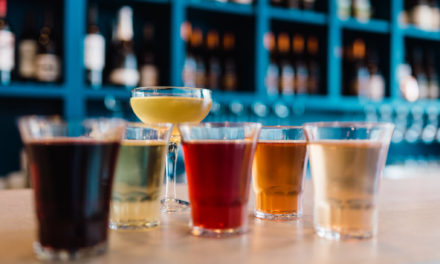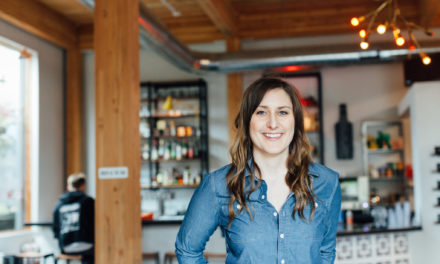In March 2020, when Patrick Lynch joined the CANarchy Craft Brewery Collective as vice president of procurement, he looked forward to increasing efficiencies among the collective’s seven member breweries and helping to launch new brands. Most of his time since, however, has been consumed by cans.

“It’s kind of a perfect storm with seltzers and sleek can needs booming, with innovation booming, and then with the pandemic at the same time.” —Patrick Lynch, CANarchy
“It’s been a daily topic since the beginning of the summer,” Lynch says. “We started hearing that some other craft brewers were having issues getting cans and that the market was getting tight. We thought, ‘Hey, we’re making it through okay.’ Then all of a sudden, we hit August and Ball [Corporation] called and said it was placing us on allocation.”
CANarchy has since instituted a daily internal phone call to keep tabs on the collective’s total can supply and ensure that everyone’s needs are being met.
In late August, Oskar Blues Brewery founder Dale Katechis partnered with fellow Longmont, Colo.-based Bootstrap Brewing Co. as a private investor and adviser. The cash infusion allowed the midsized craft brewery to hire a sales director and a salesperson, install additional fermenters, speed up its canning line, purchase a depalletizer, and acquire additional QC lab test equipment as it prepared to enter into several major retail chains this spring. Now, owner Steve Kaczeus is hustling to make up for a roughly 25 percent reduction in his can supply to meet the brewery’s projected volumes.
“We have it all lined out so we’ll be able to support the additional growth we’re anticipating. It’s just going be more expensive, in some cases, to make some of these moves,” he says.
At Indeed Brewing Company in Minneapolis, Minn., brewers triple-check projections and second-guess production schedules as they wait, on a month-to-month basis, to see how many cans they’ll actually receive from a requested order. Indeed is also part of an informal phone bank among the region’s craft brewers to request or help direct the scarce supply of extra cans.
“Every little bit matters,” says Indeed Sales Director Ryan Bandy. “A small amount of extra for us might be enough for two weeks of sales for another brewery, which may be enough for a month of sales for another brewery.”
“It’s affected everybody, from Molson Coors and AB InBev all the way down to the smallest craft brewers,” says Lynch of CANarchy. “Everyone is trying to get cans.”
Bottleneck in the supply chain
While COVID-19 and its related shutdowns have exacerbated contributing factors in what some are calling the great “candemic,” for once, the rapidly spreading disease isn’t entirely to blame. Rather, the inability of existing manufacturing capacity to keep pace with the rising demand for aluminum cans is precipitated by the convergence of several prevailing trends.
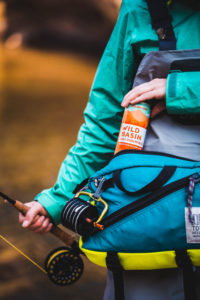 One is the adoption of aluminum cans as the preferred packaging material of American craft brewers, a trend that’s gained momentum each year since Oskar Blues became the first craft brewer to exclusively can its beers in 2002. The year 2020 marked the tipping point, when aluminum cans overtook glass bottles to become the “majority package of choice for craft brewers,” according to a letter the Brewers Association sent to its members regarding the shortage.
One is the adoption of aluminum cans as the preferred packaging material of American craft brewers, a trend that’s gained momentum each year since Oskar Blues became the first craft brewer to exclusively can its beers in 2002. The year 2020 marked the tipping point, when aluminum cans overtook glass bottles to become the “majority package of choice for craft brewers,” according to a letter the Brewers Association sent to its members regarding the shortage.
A widespread adoption of cans by other segments of the beverage industry—including hard seltzers, still and sparkling waters, soft drinks, coffees, kombuchas, energy drinks, canned wines, and ready-to-drink cocktails—has also contributed to the increased demand. And as on-premise sales have been diminished by the pandemic and consumers continue to spend more time at home, the demand for canned beverages and pantry-fill items has also increased.
Increasing production capacity
Aluminum can producers have felt this surge in demand for some time, and are working to fortify available stocks, add new production lines, and build new plants.
“Prior to COVID, 2020 was already poised for notable aluminum can growth across a variety of categories,” says Scott McCarty, communication director with Ball Corporation, the world’s largest aluminum packaging producer with 60 metal beverage packaging plants globally. “For instance, hard seltzers have experienced explosive growth as a category—and they’re almost exclusively in cans. Soft drinks and the still and sparkling water categories have seen it, too, with marketers shifting their packaging mix toward cans and away from single-use plastics. The peak summer season, with a heat wave across much of the United States, also contributed to higher demand. And COVID added further to demand, as consumers bought more beverages in aluminum cans for home consumption.”
According to a survey of its members conducted by the Aluminum Association, shipments of can stock (the sheet product that’s manufactured into cans) to U.S. markets increased 2.6 percent, year-to-date, through September 2020 over the prior year, for a total of 2,663 million pounds.
Manufacturers such as Ball, Crown Holdings, Ardagh Group, and others have also imported an estimated 2 billion cans from overseas facilities to help meet domestic demand, according to a statement from the Can Manufacturers Institute. CMI also projects manufacturers will add capacity to produce 12 billion more cans by the end of 2021.
Ball, for example, has installed two new manufacturing lines in existing facilities in Fort Worth, Texas, and Rome, Ga., and is building two new plants—one in a retrofitted factory in Pittston, Pa., and another in Glendale, Ariz.—that will provide at least 6 billion units of increased capacity by the end of 2021, McCarty says.
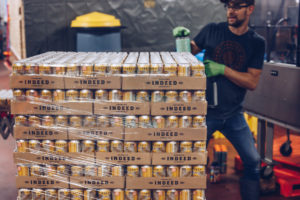
[Photo courtesy Indeed Brewing]
Growth mode meets limited supply
Renewed stability in the supply chain can’t come soon enough for brewers such as Bootstrap’s Kaczeus, who are poised to capitalize on new opportunities and need a reliable supply of materials to do so. In addition to beginning contracts with major retailers like Walmart and Costco this spring, Bootstrap also recently introduced a non-alcoholic beer, called Strapless, as well as a line of hard seltzers called Sparkalicious. Both are packaged in aluminum cans.
Bootstrap went all-in on cans about six years ago, when it moved away from mobile canning and purchased its own canning line from Wild Goose Canning. Today, the brewery runs about 3 million cans through its line each year, with an annual production of about 9,000 barrels, Kaczeus says. He expects to produce closer to 15,000 barrels in 2021.
“We’ve had contracts with one of the larger can manufacturers in the States, but in September, we got notice that things would get cut back by about a 25 percent reduction in Q1 and Q2 of 2021,” Kaczeus says. “Thankfully they gave us enough notice and we’ve been able to work some other options.”
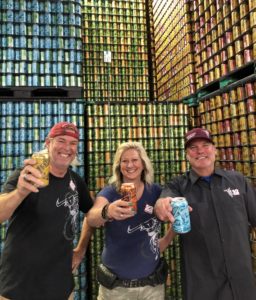
The Bootstrap crew: Steve and Leslie Kaczeus, Dale Katechis [Photo courtesy Bootstrap]
Bootstrap has also placed orders with a local company that supplies digitally printed cans, as well as with another Colorado-based company that outfits cans with shrink-wrap sleeves. The latter company will supply cans as well or will place sleeves over older, pre-printed cans with SKUs that Bootstrap doesn’t produce anymore.
“We’re also working a couple of options with some can manufacturers overseas,” Kaczeus says. With months-long lead times to import cans, “you really have to do a good job of forecasting out.” Also, without an existing relationship, most overseas manufacturers “pretty much ask for money up front, which is a cash-flow challenge,” he says. Kaczeus estimates it’s about 40 percent more expensive to import cans from overseas than to source domestically.
“Plus, since we’re not familiar with their cans, we’re asking for samples to run through our canning line and to perform high resolution optical measurements on the seams to make sure we get the right seal. Every can is just a little bit different,” he says.
Playing the waiting game
A multi-year contract and close communication with its can supplier—also Ball, in this case—has helped Indeed Brewing keep up its production while working with allocated stocks, but only through diligent number crunching, conservative expectations, and a little luck.
“We’ve tried forecasting per month, per brand, how many cans we need through December 2021 right now. Normally with cans, you never had to do that,” says sales director Bandy. “Basically, we put in what we need for, let’s say, the next five months. Then we get told maybe a few weeks before what we can get for the coming month. So far, we’ve gotten more or less what we’ve asked for. But if the state [Minnesota] shuts down all the bars, or if our projections aren’t right, we can’t go back and ask for more.”
 Indeed inquired about sourcing cans from a manufacturer in Canada, but discovered it was at capacity and not accepting new customers. Indeed also inquired overseas, but decided the upfront expense and long shipping times didn’t warrant the extra expense. Like Bootstrap, Indeed also placed label wraps over existing stocks of some of its printed 16-ounce cans, which Bandy says are particularly scarce, as are most brite, or blank, aluminum cans in all sizes.
Indeed inquired about sourcing cans from a manufacturer in Canada, but discovered it was at capacity and not accepting new customers. Indeed also inquired overseas, but decided the upfront expense and long shipping times didn’t warrant the extra expense. Like Bootstrap, Indeed also placed label wraps over existing stocks of some of its printed 16-ounce cans, which Bandy says are particularly scarce, as are most brite, or blank, aluminum cans in all sizes.
“I’ve heard [Ball] is prioritizing printed cans from customers like us, because when you do a printed can, you basically agree upfront to a blanket order of something like 7,000 cases,” he says. “For breweries that rely heavily on blank cans [that are labeled separately, typically with shrink-wrap sleeves], that’s more difficult because a lot of those breweries don’t work directly with Ball.”
Many smaller craft brewers source their cans through middlemen such as Lagersmith, American Canning, Canada-based Cask Global Canning Solutions, and other companies that break larger orders into smaller pallets, warehouse those cans, and then sell them to smaller breweries as needed. But even those stockpiled supplies are beginning to dry up.
“There’s a chokehold right now for everyone, including breweries and for other suppliers,” Bandy says.
Oskar Blues and the rest of the CANarchy Craft Brewery Collective (which also includes Cigar City Brewing, Wasatch Brewery, Squatters Craft Beers, Perrin Brewing Co., Three Weavers Brewing Company, and Deep Ellum Brewing Co.) was in the middle of a four-year contract with Ball when it was notified that supplies would be allocated this past August. “We’re looking to contract out a little further into the future right now,” says Lynch.
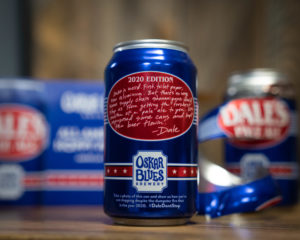 Last year, CANarchy also consulted with Ball to hedge the aluminum market and lock-in its pricing and projected volumes for 2021. “It’s committed to meeting those requirements, so we feel like we’re in a pretty comfortable space with Ball right now. But it will be a week-to-week, month-to-month situation to make sure we’re getting what we need,” Lynch says.
Last year, CANarchy also consulted with Ball to hedge the aluminum market and lock-in its pricing and projected volumes for 2021. “It’s committed to meeting those requirements, so we feel like we’re in a pretty comfortable space with Ball right now. But it will be a week-to-week, month-to-month situation to make sure we’re getting what we need,” Lynch says.
CANarchy also ended up sleeving about 2 million obsolete 12-ounce cans last fall to help it get through “until our volumes with Ball loosen back up,” he says.
“The tightest part for us has been sleek cans [the taller, skinnier variety of 12-ounce aluminum cans], which are just booming as a package type,” he says. Oskar Blues uses sleek cans to package its Wild Basin line of hard seltzers.
“It’s kind of a perfect storm with seltzers and sleek can needs booming, with innovation booming, and then with the pandemic at the same time. It’s really just crushed the can market,” Lynch says. “There’s a lot of can capacity coming, but I still don’t think it’s enough to meet the demand. I think 2021 is still going to be a very tight year for cans.”


